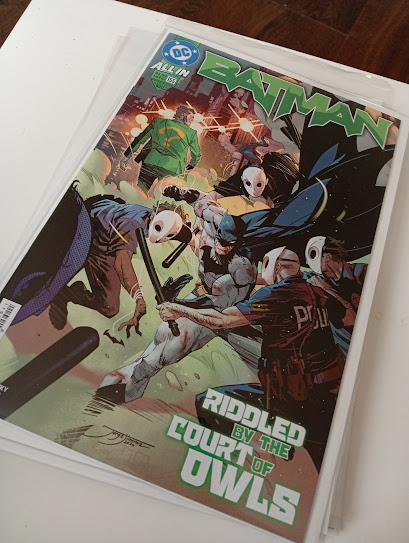Comic Review: Batman #155 — Zdarsky, Fornés, and the Dark Mirrors of Morality
Batman #155 continues the main thread of the current arc, unafraid to delve into personal, controversial, and morally ambiguous territory. Chip Zdarsky maintains his narrative with consistency, blending noir atmosphere with psychological drama and detective intrigue, all while drawing deeply from Batman’s mythos. And while this issue isn’t without its flaws, it boasts emotional depth and several clear strengths worth highlighting.
Old Wounds and New Suspicions
The plot of Batman #155 is built on the solid foundation of an investigation: Batman is trying to determine who’s behind a murder that—based on all available evidence—seems to implicate one of his closest allies: Commissioner James Gordon. Bruce wants to believe in Gordon’s innocence, but as new clues surface and Gordon’s past resurfaces, even the Dark Knight begins to doubt.
What begins as a classic whodunit quickly morphs into a personal journey into the soul. Gordon had an affair with the victim—a woman he was involved with long before tragedy struck. For Batman, this hits like a hammer blow. Following the betrayal by his father (as seen in earlier issues) and decades of living in the shadow of secrets, Bruce is once again faced with the painful truth: maybe he never really knew the people he trusted.
The emotional climax comes in a dreamlike monologue from Gordon: “What does it mean to be the only good man?” — a question that resonates with the reader and Batman alike, forcing reflection on one’s role in a city built on lies, corruption, and half-truths.
Riddler the Puppeteer
The final answer to the murder mystery turns out to be somewhat disappointingly familiar: mind control. Yes, it seems Edward Nygma, the Riddler, is behind recent events.
Zdarsky’s choice here can be read in two ways. On one hand, it robs the story of some emotional weight—after all, Gordon wasn’t truly responsible. On the other hand, it casts the Riddler in a disturbing new light. No longer a jokester in a green suit, he’s portrayed as a master manipulator capable of dismantling Batman’s most important relationships—with his family, friends, and mentor. In Riddler’s hands, Gotham becomes a logical chessboard, and people are pieces he moves with surgical precision.
There are clear nods to Hush, but Zdarsky avoids lazy recycling. In fact, it feels as though he’s attempting to craft his own definitive take on Nygma—not centered on word puzzles, but on psychological terror. And it works quite well.
A Visual Feast with a Hint of Nostalgia
Jorge Fornés—known for Batman: The Imposter and Rorschach—once again proves that his style is perfectly suited to noir stories. In Batman #155, the spirit of Batman: Year One is palpable, both in the framing and the gritty urban aesthetic. One standout panel shows Gordon sitting on a bed with a cigarette, clearly referencing a scene from Frank Miller’s classic run where Gordon contemplates his failings with a gun in hand.
It’s these small touches—from the symbolism of hair color, to wardrobe details, to subtle facial expressions—that give the story real depth. Fornés doesn’t just illustrate—he tells a story through images with rare nuance.
Pros:
+Strong character psychology – Batman’s doubt, Gordon’s torment, and Bruce’s haunted past give the story rich emotional texture. These are flesh-and-blood characters, not marble statues.+Outstanding artwork by Jorge Fornés – Retro-noir style that beautifully matches the story’s tone, with powerful use of silence and emptiness in the panels.
+Riddler in top form – An intellectual villain who doesn’t need fists to win. Menacing because he’s effective.
+Return to detective roots – Batman is finally doing real detective work again, not just fighting.
Cons:
– Too convenient a plot twist – The mind control trope, while logical, undermines dramatic tension and absolves Gordon a bit too neatly.
– Overstuffed with subplots – Court of Owls, Bruce’s mysterious brother, a new “hero,” Thomas Wayne’s betrayal—too much at once, leading to confusion and fatigue.
– Increasingly heavy-handed political tones – While it’s commendable to address real-world issues, the balance between narrative and commentary is starting to slip. It worked well in issue #153—here, it feels intrusive.
Conclusion
Batman #155 is packed with emotion, drama, and moral dilemmas. Zdarsky crafts a story about trust, guilt, and manipulation, set in a claustrophobic, uncertain Gotham where no one is spotless. Though it stumbles in a few places—especially with its reliance on convenient twists and overstuffed plotting—its emotional core remains strong, and Jorge Fornés’s artwork elevates the experience significantly.
This issue may not go down in Batman history as a landmark, but it’s a valuable piece of the larger puzzle. If future issues tie the arc together with sufficient power, #155 will be remembered as an important stop on this emotional journey.
My Score: 7/10


















No comments